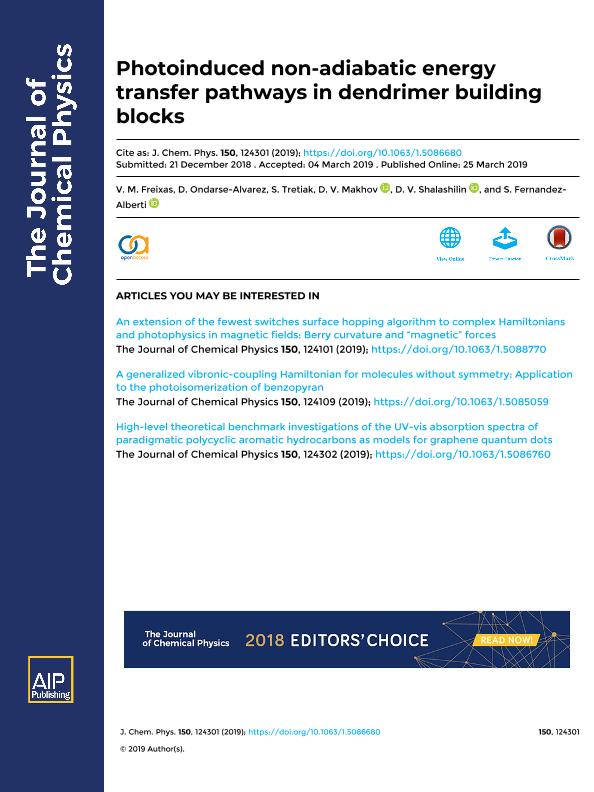Mostrar el registro sencillo del ítem
dc.contributor.author
Freixas Lemus, Victor Manuel

dc.contributor.author
Ondarse Alvarez, Dianelys

dc.contributor.author
Tretiak, Sergei

dc.contributor.author
Makhov, D.V.
dc.contributor.author
D. V. Shalashilin
dc.contributor.author
Fernández Alberti, Sebastián

dc.date.available
2020-11-13T13:36:35Z
dc.date.issued
2019-03
dc.identifier.citation
Freixas Lemus, Victor Manuel; Ondarse Alvarez, Dianelys; Tretiak, Sergei; Makhov, D.V.; D. V. Shalashilin; et al.; Photoinduced non-adiabatic energy transfer pathways in dendrimer building blocks; American Institute of Physics; Journal of Chemical Physics; 150; 12; 3-2019; 1-11
dc.identifier.issn
0021-9606
dc.identifier.uri
http://hdl.handle.net/11336/118322
dc.description.abstract
The efficiency of the intramolecular energy transfer in light harvesting dendrimers is determined by their well-defined architecture with high degree of order. After photoexcitation, through-space and through-bond energy transfer mechanisms can take place, involving vectorial exciton migration among different chromophores within dendrimer highly branched structures. Their inherent intramolecular energy gradient depends on how the multiple chromophoric units have been assembled, subject to their inter-connects, spatial distances, and orientations. Herein, we compare the photoinduced nonadiabatic molecular dynamics simulations performed on a set of different combinations of a chain of linked dendrimer building blocks composed of two-, three-, and four-ring linear polyphenylene chromophoric units. The calculations are performed with the recently developed ab initio multiple cloning-time dependent diabatic basis implementation of the Multiconfigurational Ehrenfest (MCE) approach. Despite differences in short time relaxation pathways and different initial exciton localization, at longer time scales, electronic relaxation rates and exciton final redistributions are very similar for all combinations. Unlike the systems composed of two building blocks, considered previously, for the larger 3 block systems here we observe that bifurcation of the wave function accounted by cloning is important. In all the systems considered in this work, at the time scale of few hundreds of femtoseconds, cloning enhances the electronic energy relaxation by ∼13% compared to that of the MCE method without cloning. Thus, accurate description of quantum effects is essential for understanding of the energy exchange in dendrimers both at short and long time scales.
dc.format
application/pdf
dc.language.iso
eng
dc.publisher
American Institute of Physics

dc.rights
info:eu-repo/semantics/openAccess
dc.rights.uri
https://creativecommons.org/licenses/by-nc-sa/2.5/ar/
dc.subject
DYNAMICS
dc.subject
EHRENFEST
dc.subject
CLONING
dc.subject
POLYMERS
dc.subject.classification
Físico-Química, Ciencia de los Polímeros, Electroquímica

dc.subject.classification
Ciencias Químicas

dc.subject.classification
CIENCIAS NATURALES Y EXACTAS

dc.title
Photoinduced non-adiabatic energy transfer pathways in dendrimer building blocks
dc.type
info:eu-repo/semantics/article
dc.type
info:ar-repo/semantics/artículo
dc.type
info:eu-repo/semantics/publishedVersion
dc.date.updated
2020-11-11T12:32:30Z
dc.journal.volume
150
dc.journal.number
12
dc.journal.pagination
1-11
dc.journal.pais
Estados Unidos

dc.journal.ciudad
New York
dc.description.fil
Fil: Freixas Lemus, Victor Manuel. Universidad Nacional de Quilmes. Departamento de Ciencia y Tecnología; Argentina. Consejo Nacional de Investigaciones Científicas y Técnicas; Argentina
dc.description.fil
Fil: Ondarse Alvarez, Dianelys. Consejo Nacional de Investigaciones Científicas y Técnicas; Argentina. Universidad Nacional de Quilmes. Departamento de Ciencia y Tecnología; Argentina
dc.description.fil
Fil: Tretiak, Sergei. Los Alamos National Laboratory; Estados Unidos
dc.description.fil
Fil: Makhov, D.V.. University Of Leeds; Reino Unido
dc.description.fil
Fil: D. V. Shalashilin. University Of Leeds; Reino Unido
dc.description.fil
Fil: Fernández Alberti, Sebastián. Universidad Nacional de Quilmes. Departamento de Ciencia y Tecnología; Argentina. Consejo Nacional de Investigaciones Científicas y Técnicas; Argentina
dc.journal.title
Journal of Chemical Physics

dc.relation.alternativeid
info:eu-repo/semantics/altIdentifier/url/http://aip.scitation.org/doi/10.1063/1.5086680
dc.relation.alternativeid
info:eu-repo/semantics/altIdentifier/doi/http://dx.doi.org/10.1063/1.5086680
Archivos asociados
